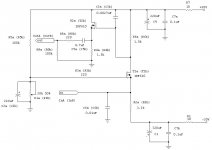Now AndrewT you can add a new page with the negative leg for the joy of us all 😉
(if wish and if you have some spare time, of course)
(if wish and if you have some spare time, of course)
Your link took me to a Salas post1151.
Where should the link have taken me?
Use "copy link location" .
Where should the link have taken me?
Use "copy link location" .
Last edited:
I will not need a different +ve and -ve version.
I have repeated so many times that the -ve version using only Nchannel devices does both polarity jobs more cheaply and just as well, if not better.
A PCB created for either a +ve version, or a -ve version can very easily be adapted to the other polarity.
I have repeated so many times that the -ve version using only Nchannel devices does both polarity jobs more cheaply and just as well, if not better.
A PCB created for either a +ve version, or a -ve version can very easily be adapted to the other polarity.
Hello,
Some of you may have seen in the Salas Simplistic HV Shunt Reg thread that I have created a small Excel spreadsheet to make calculations of the CCS resistor and MOSFETs dissipations easier.
Well, the BiB already has an excellent build guide, but it was easy enough to modify the HV spreadsheet to make a SSLV1.1 version of the calculator.... so here it is in case it helps someone:
https://docs.google.com/open?id=0B4Rnva0idfhAMmM1ZWM1ODgtOTczYy00M2RmLWI1NDEtYjljZTlhZDIwY2Iy
If you have any question, do not hesitate to ask. Cheers!
Fred
This is the post I tried to link to, I thought I had copied link location in last post as you suggest. The arrow in quote should take you to Post 903.
Lazybutt's spreadsheet is here
http://www.diyaudio.com/forums/power-supplies/192625-sslv1-1-builds-fairytales-19.html#post2861878
No wonder I did not know it existed. It's in Googledocs.
Why did he not attach the doc?
At least it is sorted and now appears in post1.
http://www.diyaudio.com/forums/power-supplies/192625-sslv1-1-builds-fairytales-19.html#post2861878
No wonder I did not know it existed. It's in Googledocs.
Why did he not attach the doc?
At least it is sorted and now appears in post1.
New R103 value of 3.9K, and voltage achieved on the +ve reg. Cheers all for the help.
Congrats and welcome to the BiB club🙂
what do you mean when telling digital Vref 220 uF ?
Interesting setup
you are powering only Pass I/V with Salas BIB regulator and everything else with EB serial regulators ? what Is your output voltage fed to Pass I/V what Is your current through CCS ?
CX01-CX02 near the rectangle "SEE TEXT"
Vout +-30V CCS 200mA
thank you for reply
that Is why I am asking
why It Is recommended to use big capacitance for supplying digital circuits
that Is why I am asking
why It Is recommended to use big capacitance for supplying digital circuits
It is recommended for C101 so to filter deeper the voltage reference because clocks and the like are supposed to be more sensitive to sub audio band 1/F noise.
thank you Salas
and what about output cap - Is It same like Vref filter cap or It can be times lower - so we can use only film cap
and what about output cap - Is It same like Vref filter cap or It can be times lower - so we can use only film cap
That's an RC termination system designed to keep the reg's phase margin ample. It does not significantly filter anything. Use the recommended Zobel values.
OK
we have to use In general RC output termination network without 220 uF
and 200 uF cap when we have digital like and unpredicted parallel loads such decoupling parts
same Is for Vref filter
Is that correct
we have to use In general RC output termination network without 220 uF
and 200 uF cap when we have digital like and unpredicted parallel loads such decoupling parts
same Is for Vref filter
Is that correct
You can keep the arrangement but WITHOUT deleting R1 and R7, or delete all those elements. Its local RC filtering and its subjective what you will prefer. Most times some people just prefer to use the reg without local extras.
If the regulator outputs are located exactly on the amplifier power inputs then the local MF & LF decoupling can be dispensed with.
You can design the two PCBs, PSU & Amplifier, to stack bottom face to bottom face to get as little as 2mm of lead length (a solid copper link) to make best use of very short lead lengths and very low added inductance.
I am not so sure the HF decoupling can be dispensed with, I suspect this is still required across the main output device, i.e. right across the output device, T2a Drain PIN to R4a GND PIN.
C7a is shown in the wrong position on the schematic. C7b may be near useless in it's present location.
You can design the two PCBs, PSU & Amplifier, to stack bottom face to bottom face to get as little as 2mm of lead length (a solid copper link) to make best use of very short lead lengths and very low added inductance.
I am not so sure the HF decoupling can be dispensed with, I suspect this is still required across the main output device, i.e. right across the output device, T2a Drain PIN to R4a GND PIN.
C7a is shown in the wrong position on the schematic. C7b may be near useless in it's present location.
Last edited:
- Home
- Amplifiers
- Power Supplies
- SSLV1.1 builds & fairy tales
